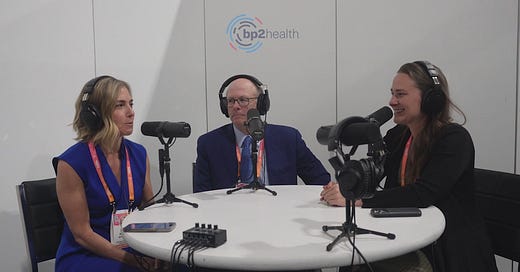There has been quite a bit of chatter lately around front-of-package nutrition, the need to understand nutritional density and whether the FDA is doing enough in general. Especially in light of the fact that 75% of the “food” in grocery stores isn’t actually food at all by definition.
FOOD (noun) - any substance consumed by an organism for nutritional support and energy
Well what better a way to ponder the FDA’s vision than to hear it directly from the proverbial “horses mouth”.
Late 2024, Erin Martin (FreshRX Oklahoma), Justin Politi (one of partners at BP2 Health) and I had the chance to sit down with the FDA’s Deptuty Deputy Commissioner for Human Foods - Jim Jones. In this role, which reports directly to the FDA Commissioner, Jones leads the unified Human Foods Program (HFP), overseeing all FDA food safety and nutrition activities. He is actually the first person to hold this role that was created in 2023.
When you read his background, you realize he might be a bit of a secret weapon for Making America Healthy Again #MAHA. He spent most of his career as a federal regulator of pesticides, toxic substances, chemical safety, and pollution prevention at the U.S. Environmental Protection Agency (EPA) and spent much of his tenure involved in leadership and decision-making related to food safety. As a principal architect of the 2016 overhaul of the Toxic Substances Control Act, Jones led discussions with members of Congress, industry and environmental groups that resulted in a law reshaping how chemical safety is managed in the U.S. And these are just a few of the highlights.
“My view is that we have 330 million Americans that we really want to improve their nutrition, and I want to do it for everybody. - Jim Jones
Call me a pollyanna, but after our power-packed 15 minutes where Jim shared a few of the highlights of what the FDA has planned, I felt it wasn’t all doom and gloom:
A rule that will describe the parameters for when a food can say that it's healthy. And the development of a logo so that consumers can start to see on packaging some consistency around how they can be able to recognize the healthy designation. This will identify products designated as healthy across product categories and within product categories
Taking comment from all stakeholders right now, what we refer to as Phase II of sodium reduction goals. Phase I just ended last April and with a 2.5 year goal to achieve a 13% reduction in average sodium consumption by Americans. The early data that we have indicates about 40% of the categories meeting or close to meeting the first reduction
Planning to propose bringing three nutrients from the back of the label to the front of the label, in a way that's very easily understood by the consumer (Sodium, added sugar and saturated fat). Putting that on the front of the label with some descriptor related to it. (This was actually announced by the FDA a few weeks ago)
We discussed whether there is a universe where there are fewer chemicals in our foods
We talked about
and Edacious and the need for nutritional densityWe talked about work that includes Instacart to help them help their customers quickly understand what foods they are buying through Instacart that are good for them
“At the FDA we have a lot of knowledge around nutrition, chemical safety, how that can then be translated in new technologies in the private sector to help consumers buy and get healthier food, and I think that that can play a huge role in how people get healthier” - Jim Jones
Despite all of this promise, we seem to all find ways to pick things apart. We all seem to say it isn’t enough and that the evil empire of food/pharam/chemicals will find a way around.
Which brings me to the question I started with…
Is incremental change better than no change at all?














Share this post